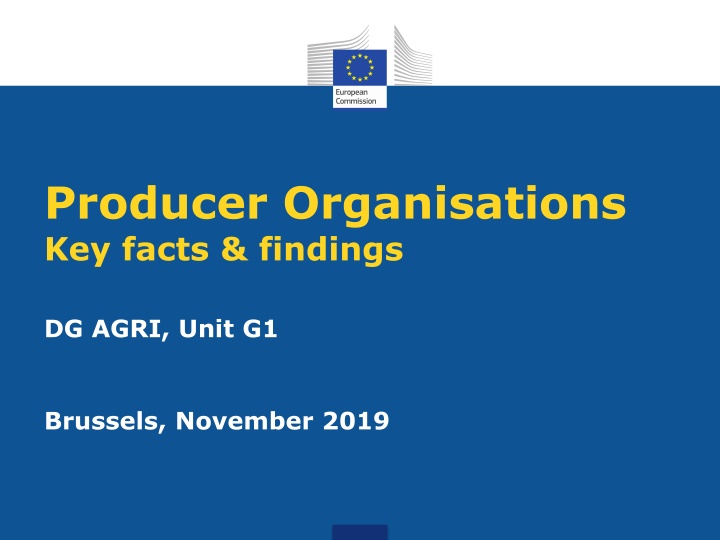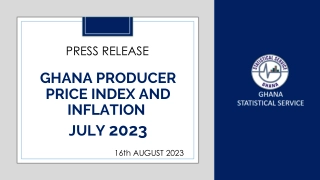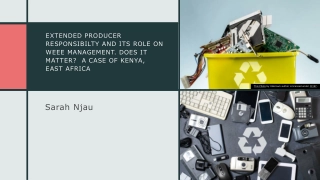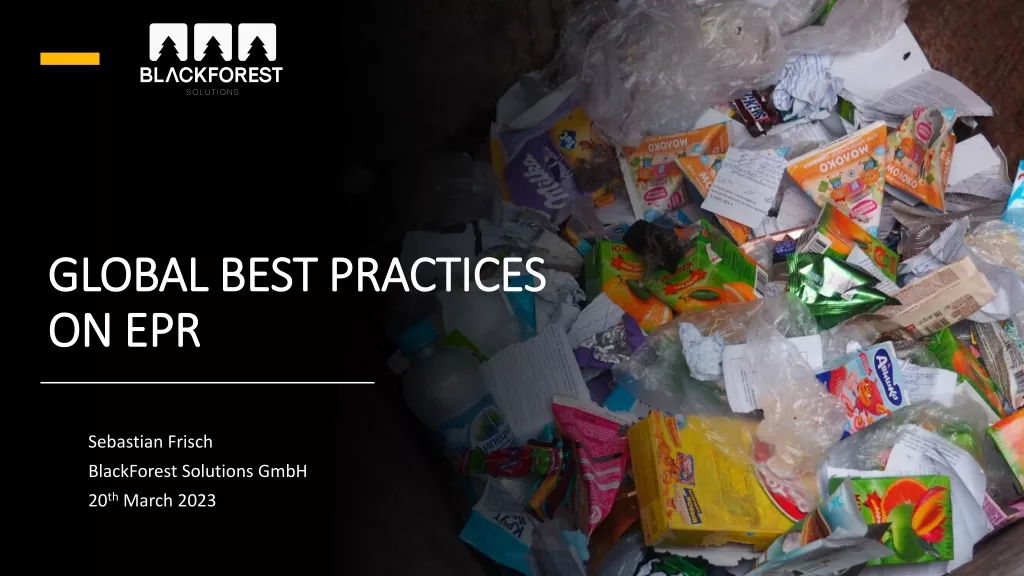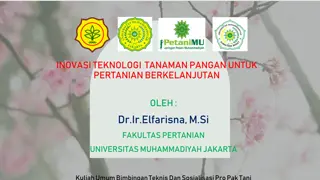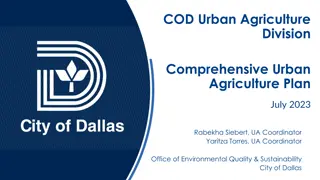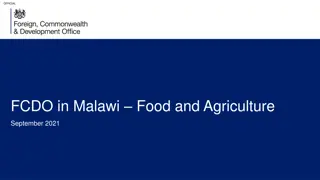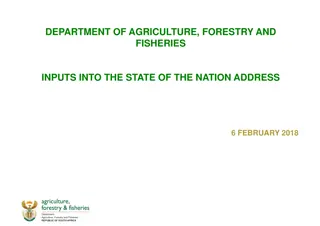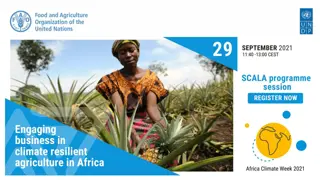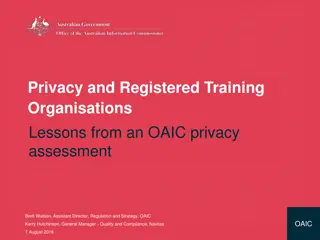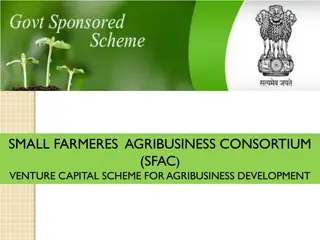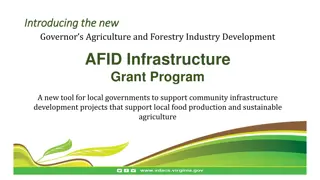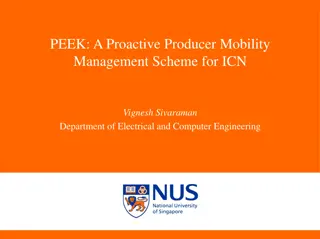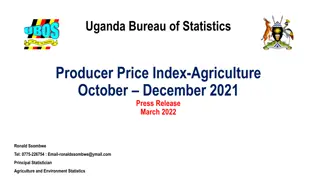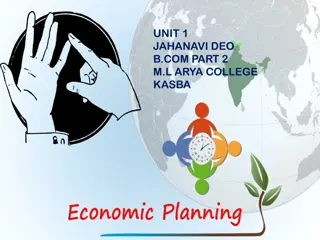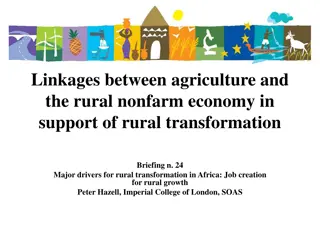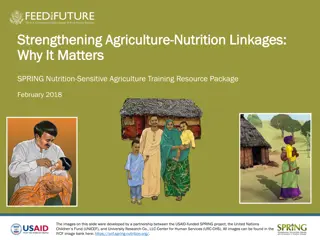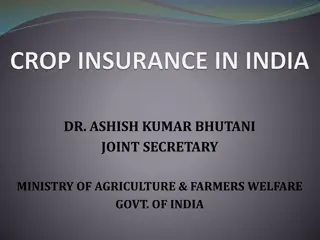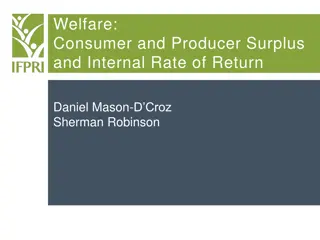Insights on Producer Organisations in Agriculture Sector
Explore key facts and findings related to producer organisations in the agriculture sector, including their definition, roles, recognition, and classification. Learn how producer organisations contribute to strengthening the position of producers in the food chain and the implications of EU regulations on their activities.
Download Presentation

Please find below an Image/Link to download the presentation.
The content on the website is provided AS IS for your information and personal use only. It may not be sold, licensed, or shared on other websites without obtaining consent from the author.If you encounter any issues during the download, it is possible that the publisher has removed the file from their server.
You are allowed to download the files provided on this website for personal or commercial use, subject to the condition that they are used lawfully. All files are the property of their respective owners.
The content on the website is provided AS IS for your information and personal use only. It may not be sold, licensed, or shared on other websites without obtaining consent from the author.
E N D
Presentation Transcript
Producer Organisations Key facts & findings DG AGRI, Unit G1 Brussels, November 2019
Definition of producer organisations POs can be defined as any entity that o has been formed and is controlled by producers o in a specific sector (horizontal cooperation) o to pursue jointly one or more of the objectives listed in the CMO Regulation o whether or not the entity is formally recognised POs can take various legal forms, incl. cooperatives, associations, or private companies in which agricultural producers are shareholders 2
Role of producer organisations Regulation (EU) 1308/2013, CMO Regulation : (131) Producer organisations and their associations can play useful roles in concentrating supply, in improving the marketing, planning and adjusting of production to demand, optimising production costs and stabilising producer prices, carrying out research, promoting best practices and providing technical assistance, managing by-products and risk management tools available to their members, thereby contributing to strengthening the position of producers in the food chain. 3
Recognition of producer organisations The CMO Regulation (Art. 152) foresees the possibility for Member States (MSs) to recognise POs that o are formed by producers o follow democratic principles o carry out joint activities o pursue certain objectives Certain recognised POs can receive financial support through EU funds (rural development, operational programmes) Recognised POs can also benefit from certain derogations from EU competition rules 4
Classification of producer organisations All POs Recognised POs Agricultural cooperatives that are recognised POs Agricultural cooperatives 5
Structure of the EU food supply chain Farmers 10 million small and fragmented agricultural holdings Gatekeepers A few large manufacturers generate 90 percent of the turnover A few large food & drink retailers dominate the market 500 million individual consumers dispersed across 28 MSs Consumers 6
Market power of farmers Many small farmers individually face few consolidated downstream operators 7
Greater market power of POs Horizontal cooperation between farmers can help balance the economic asymmetry within the FSC 8
Benefits of farmer cooperation Cooperation between farmers makes activities possible that can benefit them by generating added value that they could not achieve on their own, e.g. o better market access (e.g. thru concentration of supply, joint marketing or distribution) o greater contractual leverage vis- -vis buyers of their products and suppliers of agricultural inputs o more efficient production (e.g. through better access to technical knowledge, risk management mechanisms) 9
Wider benefits of farmer cooperation Cooperation between farmers can also bring advantages to the rest of the food supply chain Dealing with fewer POs instead of many farmers can help downstream operators reduce transaction costs: o lower uncertainty for their long-term planning o fewer business relationships and more stable prices o more efficient organisation and delivery of supplies o better quality assurance (specs, traceability, safety) 10
Competition rules prohibit cooperation EU competition rules are laid down in the TFEU (Treaty on the Functioning of the European Union): o Art. 101 prohibits agreements between undertakings that affect trade or competition (e.g. price fixing) o Art. 102 prohibits abuse of dominant market positions (e.g. to impose unfair trading conditions) >> Farmers who collaborate to obtain e.g. a stronger bargaining position could run afoul of these rules Art. 42 allows legislators to limit the application of competition rules in the agricultural sector 11
Legal basis for farmer cooperation The CMO Regulation (amended by the Omnibus Regulation 2017/2393) details the derogations from competition rules in the agricultural sector: o Art. 152 exempts recognised POs from certain competition rules (e.g. planning production, placing products on the market, negotiating supply contracts) o Art. 209 exempts farmers, farmers associations and recognised POs from the prohibition of certain agree- ments e.g. on production or sale of agricultural products o Art. 222 allows further derogations for recognised POs during periods of severe imbalance in markets 12
Number of recognised POs by MS In 2017 there were >3,400 recognise POs in the EU (2018: >3,700), and 71 recogn. associations of POs The MSs with most such entities were France (759), Germany (658), Spain (588) and Italy (563), followed by Poland (250), Greece (239) and Portugal (139) In each of the other MSs there were fewer than 70 recognised entities (309 in total), and in Estonia, Lithuania and Luxembourg there were none at all 13
Frequency of POs across Member States In 2017 the number of recognised entities per million holdings was 254 on average across the EU In Germany there were 2,314 recognised entities per million holdings, followed by France (1,403), Czech Republic (1,397), Spain (585), and Belgium (490) 2,314 o This does not say anything about the effectiveness of the POs: In a MS with few but larger recognised entities, more farmers could be organised in such (stronger) POs than in a MS with many small ones 1,403 1,397 585 490 390 360 328 231 194 187 159 153 104 80 70 67 63 55 43 20 14 5 5 5 0 0 14 DE FR CZ ES BE PT IT EL CY NL UK PL AT HU MT SE SI FI BG HR SK IE DK LV RO EE LT
Numbers by sector & diversification In 2017 the following numbers of entities were recognised in the various sectors: 1,851 (about half) in fruit & vegetables, 334 in dairy, 254 in olives, 222 in wine, 210 in beef, 177 in cereals, 101 in pig meat, 89 in sheep & goat meat, and 267 in all other sectors POs in fruit & vegetables (F&V): 77% market at least three crops, 10% market two crops, and 12% market only one 15
New recognitions of POs over time 2018: >3,700 in total 1,216 921 814 407 Before 1990 1990-00 2001-10 Since 2011 16
Distribution of legal forms of POs More than half of all recognised POs are cooperatives, but there are big differences across MSs 227 0 1 5 91 42 5 1 280 1 38 94 24 5 464 30 219 18 17 9 2 1 5 1 5 13 35 459 191 19 3 342 293 1 31 43 10 2 183 4 22 1 0 0 0 0 0 0 0 0 0 0 0 0 0 0 AT BE BG CY CZ DE DK EE EL ES FI FR HR HU IE IT LT LU LV MT NL PL PT RO SE SI SK UK Cooperatives Other legal forms 17
Size of recognised POs In 2017 in F&V, only 6 percent (107 out of 1,659) of all recognised POs had a turnover over 50 million, while 7 percent had a turnover below 500k Companies with a turnover up to 50 million are considered small and medium-sized enterprises (SMEs) and those with a turnover up to 2 million are considered micro enterprises o Most recognised POs are not bigger than SMEs and many would not even qualify as small enterprises o But in Italy and France 10 and 9 entities, respectively, reported a turnover of more than 100 million/year 18
Size of recognised POs In terms of members, more than a third of recognised POs (38%) has fewer than 100 members, while most recognised POs (90%) have fewer than 1,000 Not directly comparable, but companies with less than 250 people count as SMEs, those with less than 50 as small enterprises (if also below the turnover ceilings) o In Italy one quarter of POs has >2,000 members >> Is there a crucial size for POs to be able to strengthen the position of producers in the food supply chain in a viable manner? 19
Multiple objectives of recognised POs Production planning and adjustment to Concentration of supply Placing of products on the market (incl. Optimisation of production costs and of Improvement of product quality Environmentally sound cultivation Stabilisation of producer prices Production standards Sustainable use of natural resources Promotion and marketing initiatives Management of by-products and waste Research on sustainable production Developing protected designation of Management of mutual funds Technical assistance for the use of Sound animal welfare practices and Promotion and technical assistance F&V POs Dairy POs Other rec. POs 20 0% 25% 50% 75% 100%
Multiple activities of recognised POs Planning of quantity Planning of quality Contractual negotiations Organisation of quality control Commercialisations strategies Use of equipment or storage Quality control Packaging Labelling or promotion Processing F&V POs Distribution/transport Dairy POs Procurement of inputs Management of waste Other rec. POs Other 21 0% 25% 50% 75% 100%
Marketing of F&V outside the PO Distribution of F&V POs according to the share of products they allow their members to sell outside the PO (legal maximum is 25%, 40% for organic) 21% 24% None 0 to 10 percent 10 to 25 percent 25 to 40 percent 31% 24% 22
Role of non-recognised POs in the chain According to stakeholders from POs, differentiating between recognised and non-recognised POs should not be central to an analysis of the structure of the food supply chain When farmers decide to cooperate, they first choose a legal form for their organisation, and then they reflect whether or not they should seek recognition for it Farmers do not create recognised POs, recognition is simply one of several characteristics of a PO 23
Data on non-recognised POs Data on non-recognised POs give a more complete picture of the degree of producer cooperation They can also show to which degree POs take the additional step of obtaining recognition Overall there are estimated more than 42,000 POs: o more than half (22,000) are agricultural cooperatives o the rest have other legal forms (incl. more than 10,000 French equipment-sharing CUMAs ) Of these only 8.4 percent are recognised 24
Share of recognised POs (incl. coops) 1,850 1,650 Recognised ag. cooperatives Non-recognised cooperatives Non-recognised other POs Recognised other POs 18,150 20,150 25
Study of the best ways for POs to be formed, carry out their activities and be supported: Topics: o Incentives and disincentives of farmers to join POs o Performance of producer organisations o Benefits of POs for their members o Benefits of POs for other operators in the chain Objective: o Better understand how POs can be set up to attract members and carry out their activities effectively o Better understand how POs can be supported o Keeping in mind sometimes significant differences across POs, MSs and sectors 26
Data collection & geographic coverage Interviews (120) with farm holdings which are members of a PO Interviews (120) with farm holdings which are NOT members of a PO Literature review Interviews (165) with POs and APOs in the FV and pig meat supply chain Tools 30 representatives of POs/APOs in top production areas Mapping FV sector Objective Analysis National authorities (11: 8 FV and 8 pig meat)* Representatives of POs/APOs (85: 48 FV and 37 pig meat) Supply chain actors (39) Geographic coverage BE,CZ,DE,FR,HU,IT,PL,RO (FV sector) All DE,DK,ES,FR,HU,IT,NL,PL (Pig meat sector) 27 *: Joint meetings have been organised in DE, FR, HU, IT, PL.
Assessing efficiencies generated by agricultural producer organisations: There exist no major differences in the performance of POs compared to investor-owned firms (IOFs), despite the fact that POs have to balance the needs of their members and their general corporate goals Prices paid by POs can be higher than those paid by IOFs, and the more powerful POs are, the more they pay farmers, i.e. there can be a positive relationship between PO membership and farm income POs in a market have a positive impact on its overall performance, and they often sell their products at lower prices than their competitors 28
Higher concentration of supply The share of producers in top production areas who are members of recognised POs is much higher than the corresponding national averages, e.g.: o In France, 90 percent of tomato producers in Brittany are members of recognised POs, and 75 percent of apple producers in the South-West are, while the national average for the F&V sector is 50 percent o In Poland, 40 percent of apple producers in Sandomierz and Grojecko-Warecki are members of recognised POs, while the national average is less than 15 percent The concentration of supply through recognised POs is higher in top production areas than elsewhere 29
Prices paid by producer organisations In the apple sector in Poland, the price paid by POs to their members is on average 5 cents/kg above the market price In the pig meat sector in France, the price paid by major POs per live animal can be 180 EUR above the reference price from auctions Moreover, for individual farmers there are also costs linked to participating in auctions 30
Comfort of producer organisations A main incentive for becoming member of a PO can have more to do with the comfort and convenience that a PO brings, rather than the prices it pays POs can be established to achieve wider objectives, going beyond financial performance to include development of social capital and member satisfaction Independent producers in the vicinity of a PO see the need to differentiate their production by marketing product references (sizes, packaging, production approaches) that are different from the PO 31
Economic incentives (survey) Stronger bargaining power Higher level of efficiency Fair & predictable prices Supportive investments Better commercialisation Responsiveness to crises 0% 20% 40% 60% 32 To a significant extent To some extent To a limited extent No answer
Economic incentives Greater bargaining power through joint selling: o lower transaction costs through larger volumes, marketing of baskets of complementary products, leaving fewer alternative suppliers for buyers o better prices, long-term contracts, advance payments, etc. Greater market knowledge of POs (time and expertise to study markets and new products) Greater market penetration through access to more profitable sales channels and new markets (requiring a minimum scale of production or quality certifications) 33
Economic incentives Shortening of supply chains (fewer intermediaries, better understanding of demand) Better and more predictable prices (due to greater negotiation power, market knowledge and penetration, shorter supply chains) Lower ex ante and ex post transaction costs (e.g. searching buyers or dealing with buyer opportunism and unfair trading practices) Less competitive pressure (given rules for the marketing of members products by the PO) 34
Economic incentives POs can invest in joint activities or facilities that add more value (e.g. integration thru storage or processing) Risk sharing and risk management through POs (e.g. price pooling, insurance schemes, income stabilisation/mutual funds, joint investments) Greater delivery and payment security Crisis management (e.g. timing of sales, market withdrawals) Access to bank loans through the PO 35
Economic incentives Access to IP protected varieties for which a PO obtained the rights (e.g. Pink Lady) Pre-financing of the purchase of inputs by members Joint procurement of inputs and machinery (e.g. lower prices, better delivery services, better payment terms, more informed purchasing decisions) 36
Other incentives Economies of scale (shared machinery, storage, handling, processing, marketing, quality control, traceability, business intelligence, R&D) Better inputs, machinery and related knowledge Production planning (to prevent overproduction ) Technical support (for various standards & certification) Sharing of knowledge and experiences between producers (on farming, markets, administration) Reputation of POs as reliable business partners 37
Other incentives Degree of freedom to make own decisions compared to other forms of collaboration (e.g. contract farming) Democratic decision-making within POs Social interactions within a community (the PO) and generation of social capital and trust Strengthening the countryside and rural livelihoods (e.g. while POs help farmers, they are also employers) Time saving (POs take care of non-production tasks) 38
Supporting the development of POs The most efficient & profitable POs engage in vertical integration (adding greater value) based on horizontal cooperation of farmers (producing raw materials) Lack of capital to invest in value-adding activities can be an obstacle for some Investment support schemes can further cooperation between farmers and the development of POs 39
Disincentives for joining a PO Based on interviews and the literature, disincentives for joining a PO can be sorted into three groups: o economic disincentives o regulatory disincentives o social disincentives 40
Why dont farmers join a PO? (survey) Representatives of POs in the F&V and meat sectors: Unwillingess to cooperate 72% 28% Poor regulatory environment 55% 45% Lack of trust btwn members 52% 48% Difficulties establishing POs 33% 67% Poor governance structure 26% 74% Lack of good examples 26% 74% Yes No 41
Reasons for not joining a PO Lack of information on benefits and models of POs (farmers do not know about the possibilities that POs offer nor about good examples of POs) Orientation on perceived short-term benefits (e.g. higher prices on spot markets) Loss of entrepreneurial freedom, autonomy & control (esp. in bigger POs or in POs with exclusive sales rules) Access costs (fees, operational and investment costs, compliance with PO requirements and standards, etc.) 42
Reasons for not joining a PO Potential conflicts between members (especially in more heterogeneous POs, with small vs big or young vs old farmers who think differently about the future) Satisfaction with existing sales channels and own reputation on the market (efficient markets, trustworthy partners, proximity to consumers) Interest in keeping a low profile (vis- -vis authorities) 43
Reasons for not joining a PO Lack of administrative support by national authorities Unfavourable tax systems for POs Failure stories of POs (e.g. recognised POs that had to pay back subsidies after audits by the Commission) Efficiency concerns (POs as one more intermediary) Bad press and historic reasons (forced collectivism) Subsidies reduces farmers need to cooperate 44
Reasons for seeking recognition as PO Access to EU funding (operational programmes in F&V, support to set up new POs, esp. in new MSs) Visibility and reputation vis- -vis other operators in the FSC and national authorities Legal certainty and exemption from competition rules 45
Definition of success of POs The success of a PO can be defined in different terms: its longevity, business growth, profitability, or member satisfaction Internal success factors for POs can be o an organisational & governance structure that reflects the characteristics & needs of their members o a homogeneous membership structure (similar production capacities and farm structures) o a common vision that fosters shared beliefs and values within the PO 46
Internal success factors for POs Internal success factors for POs can be o an adequate size that allows realising economies of scale while keeping administration costs in check o a competent and professional management o sufficiently strong leadership that allows efficient information transmission and decision-making o having a strategic plan for future growth (e.g. cost leadership, differentiation, innovation) o resources to fund research & innovation projects 47
External success factors for POs External success factors for POs can be: o national history of agricultural cooperation o collaborative partnerships with buyers o cooperation among POs o access to effective extension services o conducive social relationships (trust) in rural areas 48
Benefits POs can offer other operators POs can offer buyers a more stable and timely supply of agricultural products in required quantities and qualities from a single interlocutor Sourcing from fewer suppliers helps buyers stabilise the prices they pay and reduces transaction costs Bigger POs can better work with customers to adapt agricultural products to their requirements POs can provide downstream operators greater assurance in terms of traceability, quality control, compliance with food safety standards, etc. 49
Benefits POs can offer other operators Buying from POs whose members are linked to a specific rural area can help downstream operators meet consumer demand for local products Some buyers prefer to deal with recognised POs, considering them to be particularly credible and trustworthy, given that they are subject to regular monitoring by competent authorities Other farmers, who are not members of a PO, may receive better prices and conditions from their buyers to reduce their incentive to join a PO and keep the market more fragmented 50
